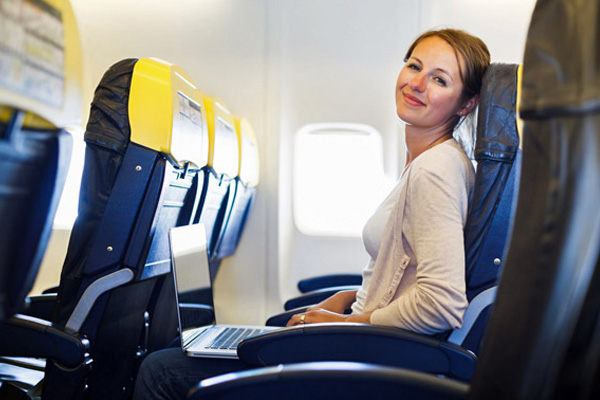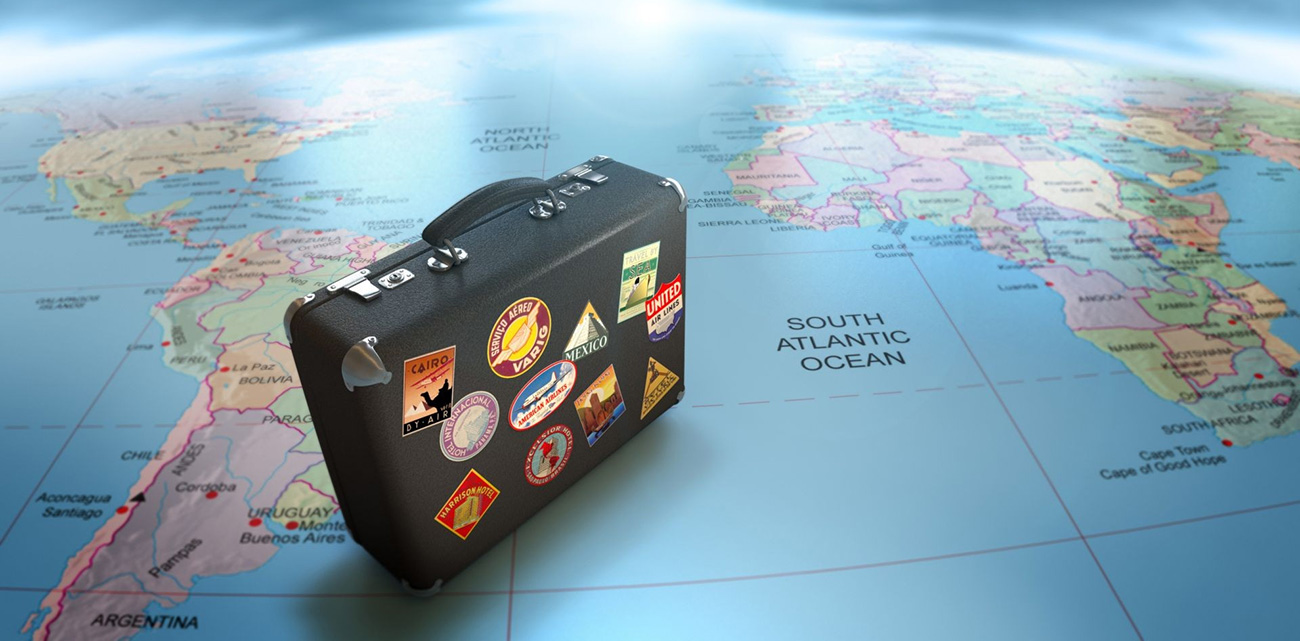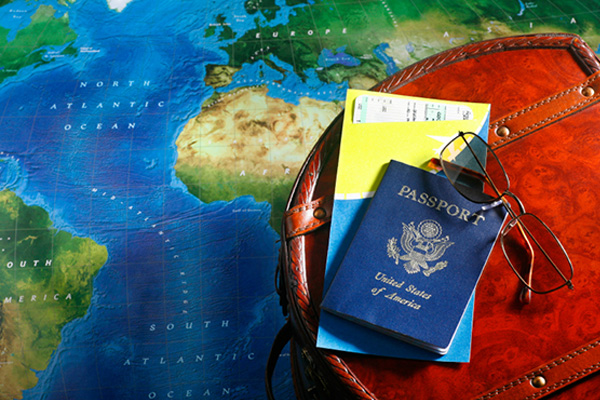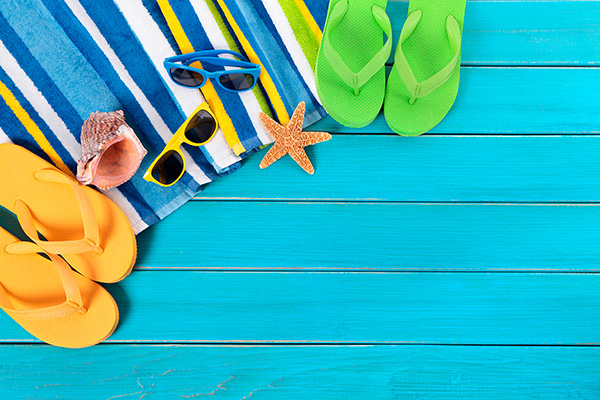Travel Tips and Tricks To Help You Travel Smart
Get to the Airport Early
Don’t chance it—get to the airport very early. Lines could be much longer than you expect.
Arrive particularly early on holidays, on weekends, and during much of the summer, and don’t underestimate the travel rush on so-called “minor holidays,” like Mother’s Day. (No offense, mom!)
Add Lumbar Support
If humans were shaped like shrimp, the C-shape of most airline seats would be super comfortable. Since we’re not, passengers regularly stumble off the plane with achy backs, necks, and legs. Sitting for long periods is already hard on your back, and without lumbar support, your spine and the muscles in your lower back have to work even harder to maintain healthy alignment. Counteract the crush by wedging a blanket, scarf, or rolled-up sweater behind you to allow your lower back to maintain its natural curve.
Stuck in the Middle Seat? Claim the Armrests
Even if you’re sandwiched between fellow passengers, your personal space needn’t be too limited. Board quickly at your first opportunity so as to make it to your seat before your seatmates, and then mark the armrests as your own.
Don’t feel guilty: It’s widely accepted that the middle passenger gets both armrests. But it’s important to claim them early, lest you find yourself next to a passenger who doesn’t buy into common courtesy.


Avoid Junk Food Before and During Your Flight
Airport concourses are lined with unhealthy eating options engineered to tempt fatigued flyers with the promise of salty, greasy comfort food. Onboard, candy and salty snacks are sometimes the only offerings.
It’s a bleak landscape of on-the-fly eating and one that can lead to dehydration, jet bloat (pressurization causes cabin air to expand inside and outside your body), and digestive problems that can dog you for days after arrival.
Seek out healthier snacks and meals (or bring your own from home) and you won’t kick off your vacation with a junk-food hangover.
Sleep in Shifts at the Airport
Whether it’s due to a long layover or bad weather, or just to save money, sometimes you need to be able to catch a few Z’s at the airport. Unfortunately, it’s not just a matter of closing your eyes and counting sheep. Sleeping in a high-traffic place like an airport can be tricky and stressful.
If you’re traveling with a companion, sleep in shifts. This way, one of you can keep an eye on the bags (and each other) while the other catches some shut-eye. After a predetermined amount of time, switch places. You’ll both get the rest and security you need.
Buy an Expandable Bag
The best way to fit more into your bag is to have a suitcase that grows with your packing needs. Expandable suitcases double as two bags in one, often starting out carry-on size but expanding to a larger bag when needed. If you’re packing for a big trip (or need extra souvenir space on a return flight), simply expand the suitcase.
Remove Makeup with Petroleum Jelly
Petroleum jelly helps to keep skin and lips moisturized and can help prevent chafing, too. But did you know it also doubles as an effective makeup remover? Dab some on a tissue to wipe off makeup—just be careful not to get it in your eyes.
Roll, Don’t Fold, Your Clothes
It may seem as if everyone from flight attendants to military members knows this trick, but it bears repeating for the uninitiated: Rolling your clothes is the best way to fit the most in a suitcase. Plus, rolled clothes tend to wrinkle less than folded clothes.

Zip and Then Add Extras
Have a few overflow items that just don’t seem like they’ll fit? Try closing and zipping your suitcase completely (even if you have to sit on it to make it work). Then reopen your bag and try adding the items in any available spot (think corners, spaces between larger items, etc.). Often, once you’ve compressed the bag by zipping it shut, you’ll find just a bit more room once you open it again.
Stuff Things Inside Your Shoes
Shoes take up a lot of space inside a suitcase. Make them do double duty by stuffing them full of small items like jewelry (in a zip-lock bag), ties (rolled up), or socks and underwear (in a plastic bag). Pack your shoes on their sides to maximize space.
Wear Breathable Fabrics on the Plane
Maintain your in-flight comfort and cleanliness by wearing breathable fabrics (materials that allow air and moisture to pass through them) such as cotton, silk, or linen. Fabrics that don’t allow air to circulate will hold sweat on the skin, likely making you feel dirtier faster and probably necessitating a good spin in the washing machine upon landing. Natural fabrics are great, but moisture-wicking manmade fabrics are suitable options as well

Separate Dirty Clothes with a Pillow Case
While traveling, separate dirty clothes from clean clothes with a pillow case, which makes a perfectly packable dirty-laundry bag. Pillow cases work well to keep luggage organized, too. Keep socks and underwear together in a pillow case in your suitcase, which you can reuse as a laundry bag once you arrive in your destination.
A pillow case is also a good tool with which to wrap the breakable souvenirs you pick up on your travels.
Substitute Baby Shampoo for Laundry Detergent
Did you know that baby shampoo can also be used as laundry detergent? We use baby shampoo to wash cashmere sweaters in the sink at home—it’s as gentle as Woolite on delicate fabrics, but less expensive. Bring a small bottle of baby shampoo with you on the road if you want to leave your travel-sized laundry detergent at home.
Baby shampoo is also commonly used to de-fog goggles. (Rub a dab of shampoo on the clear part of your goggles and then rinse.) You’ll get plenty of use out of this affordable, biodegradable product.
Use Dental Floss as an Emergency Thread
Plagued by torn hems and loose buttons? Oral-B to the rescue! Travelers in need of emergency thread can use dental floss as a substitute. It may not be as durable as some threads, but it works in a pinch. And it’s a step up from covering the hole in your pants with duct tape.
Protect Breakables with Bubble Wrap
When you receive something fragile in the mail, save the bubble wrap. It’s perfect for protecting breakables in your luggage, from wine bottles (staple the bubble wrap around the bottle) to snow-globe souvenirs. Packing apples or pears for a snack on the plane? Fold them in bubble wrap to prevent bruising. A stapled sleeve of bubble wrap also makes a suitable iPad or iPhone protector.
Walk Everywhere
Many of our favorite places are best traversed on foot. Skip the expensive sightseeing trolley and instead sign up for a group walking tour in your destination. If you’re wary of being led around a tourist trap by someone in cheesy colonial garb, don’t worry: Many destinations offer innumerable walking tours for every type of traveler, from the art buff to the culinary enthusiast. (Plus, a brisk walk between neighborhood nibbles almost outweighs the calories—we hope.)


Pick a Color Theme for Your Travel Wardrobe
Even if you don’t preplan your outfits when packing, try to pack in a color theme. For example, if you’re traveling for a week, you might commit to wearing black, navy, green, and white (and throw in pops of colors with your accessories). This helps cut down on any unnecessary extras that you never end up wearing anyway.
Polish Leather with Shampoo
Travel can be hard on leather shoes, purses, belts, and jackets, so if you find yours looking worse for the wear while you’re on the road, turn to your hotel bathroom for a quick fix. Liquid shampoo has an amazing superpower: a small amount, rubbed in circles with a cloth, can clean and restore the rich color of leather. It can also be a handy and quick way to protect leather shoes from winter salt stains.
Use Conditioner as Shaving Cream
Based on no scientific data (but plenty of anecdotal proof), we’re sure shaving cream is the most-forgotten toiletry in the travel tool kit. Man or woman, you’re likely going to need to shave at some point on any trip, so finding yourself without can be problematic. Worse, most hotels don’t offer shaving cream in their repertoire of free items. But hair conditioner, which comes standard with nearly all hotel rooms, makes a perfectly acceptable substitute. And it has the added benefit of being moisturizing, so you can be smooth and supple in one easy step.
Switch to Wi-Fi Calling
Apps such as Skype, Facebook’s Video Calling, and Google Voice will let you make unlimited calls for free as long as you’re connected to Wi-Fi.
Download Mobile-Messaging Apps
Before you go, download mobile-messaging apps such as WhatsApp, so you can easily text back and forth with friends at home and new acquaintances abroad for free. You just need to be connected to Wi-Fi to send and receive messages.
Reset Cellular Usage to Zero
Did you know that your phone keeps track of how much cellular data you’ve used? If you reset it to zero at the beginning of your trip, you can easily monitor your usage and see if your phone is sneakily using any data while you’re abroad.


Pack a Scarf
Scarves are the Swiss Army Knives of travel accessories. A good lightweight scarf can be used to dress up an outfit, as protection from the sun, to cover up bare skin in churches or mosques, or even as a makeshift pillow or eye mask on the plane. Further, if unexpectedly cool weather arrives during your vacation, a scarf will come in handy.
For a warm-weather trip, choose a breathable scarf made of cotton or linen, and seek out something in a neutral color that will go with lots of outfits. You could also try a sarong, which is basically a really big scarf that can be fashioned into a cover-up.
Change Your Phone’s Lock Screen
Concerned about losing your phone while on the road? Change your phone’s lock screen to an image that displays your emergency contact information, including your email address and an alternate phone number. If your phone is lost or stolen and a Good Samaritan finds it, he or she will easily be able to get in touch with you to return it, even if your phone is locked.
Download Offline Maps Before You Go
Do all of your downloading before you leave your home country. Go for apps that don’t need data to be usable, such as TripAdvisor’s Offline City Guides, MetrO, and PocketEarth.
Turn Off Data
If you don’t plan on using data while abroad but plan to pack your phone, there are two steps you need to take before departure: Turn off cellular data and turn off data roaming. Contact your cellular provider for further details on shutting off data.
Fail to shut down the automatic downloads that bring emails, program updates, meeting notifications, and other data to your phone and you’ll likely see some very expensive roaming charges on your bill at the end of the month.


Get a Country-Specific SIM Card
Will you be spending a lot of time in one particular country? A prepaid SIM card for the region you’re visiting is an economical choice for overseas phone usage, and it allows you to make calls and use data exactly as many locals do: through a local provider. Switch your SIM card and you’ll have a new local phone number and likely an affordable plan that puts scary-expensive international calling packages to shame. You won’t be able to make or receive calls via your usual phone number, though.
Here’s how to get one: Either pick one up prior to your departure date or get one from a local store after you arrive. We recommend the former, especially for those who don’t want to waste precious trip time shopping around for SIM cards.
But remember that not all phones will accept new SIM cards. You must have an “unlocked” GSM phone for this to work.
Make a Digital Backup With Your Smartphone
Prepare a digital backup in case your identification gets lost or stolen. With your camera phone, take a photo of your passport or driver’s license and email the photo to yourself. You might also want to take a photo of the contents of your checked bag, which may come in handy if the airline loses your luggage. (Use the photo to help document your missing belongings when filling out a claim form.) Throughout your trip, take advantage of the camera on your phone and snap photos of anything that might serve as a helpful reminder, from your airport parking-lot spot to your hotel-room number.
Use Lip Balm
Even if you don’t normally use lip balm, it can still be an important item to pack. Breathing dry airplane air, being out in the sun, eating salty foods in transit—travel inevitably leads to mild dehydration and chapped lips. And there’s something off-putting and vaguely predatory about constantly licking your lips. Lip balm can also be used to tame frizzy hair ends, soothe dry cuticles, protect skin from windburn, and even unstick a stubborn zipper.
Watch Out for Germs
Even if you’re not sitting next to someone who is obviously ill, there’s still a good chance that germs from passengers past are lurking in the cabin. Bathroom door handles, arm rests, tray tables, seat-back pockets, and seat-back screen controllers are among the surfaces that get dirty fastest and might not be properly disinfected between flights. Shared airplane blankets and pillows, especially those not sealed in plastic when you board, also tend to be germ factories.
Since nothing ruins a vacation faster than coming down with a cold or the flu, it’s key to be vigilant against germy surfaces when you fly. Wash your hands often or use hand sanitizer.
Ease Into a New Time Zone
A popular practice among junk-science enthusiasts, staying up all night before your flight to confuse your internal clock and fight jet lag mostly just makes you more tired and prone to illness and stress. And that sets a bad tone for any trip.
Instead of pulling an all-nighter, aim for good sleep before your trip and use the flight time to ease yourself into the destination’s time zone by sleeping and waking according to the clock where you’ll land.
Don’t Sit Still
Sitting in an airplane seat is hard on your body. If you’re not moving and stretching at regular intervals in-flight, you’re putting yourself at risk. Opt to remain in your seat for hours at a time and you’ll likely arrive with the aches and pains of tight muscles. More seriously, people who sit still for long periods have a higher likelihood of developing deep vein thrombosis (DVT), a condition in which a blood clot forms, usually in the leg.
DVT causes leg pain, but the real concern is that part of the clot could break off and flow to the heart or brain, causing severe injury or death. The FAA advises airline passengers to increase leg-muscle activity while flying by walking around in the cabin or exercising lower legs and ankles from a seated position.

Pack Your Batteries Separately
Packing your electric toothbrush or razor? Make sure you either take the batteries out or tape the item’s switch in the “off” position. Battery-powered devices can easily turn on after being jostled around in a carry-on, which can in turn draw the attention of security. Play it safe and pack your batteries separately from your battery-powered items.
Buy a Lounge Day Pass
Comfortable chairs and soothing music, plus free snacks, drinks, and Wi-Fi: This is the siren song of the airport lounge. While annual passes to airline and airport lounges tend to be pricey, a day pass can be a worthwhile expense, especially if you’ve got a long wait or simply want a quiet place to relax before your flight.
As an added stress buster, airline-affiliated lounges usually staff a desk where you can make flight changes without needing to stand in a long line at a customer-service counter.
Pack the Right Shoes
Ever wonder why your bag always seems so heavy by the time you’re finished packing? Shoes—especially boots, wedges, and just about any men’s work or dress shoe—may be the culprit. And many ultralight options have their drawbacks: There’s only so far you can walk in flimsy flats, and lightweight sneakers don’t always deliver on the fashion front.
When it comes to shoes, packing light and well is a tricky balancing act between bulk, style, and comfort. Since shoe needs and preferences are highly individual, there’s no one-size-fits-all solution.
Keep Your Phone Hidden
While there are a great many useful travel apps you can employ for mapping, translation, and general destination overviews, avoid unwanted attention from would-be muggers by keeping your phone out of sight.
Before leaving your accommodations, map out the route to your next destination in your head. If the way is too complicated, write it out on paper. If you prefer a map, circle your destination, fold the map into a small square that fits in one hand, and avoid spreading out the full-sized map before your face (this marks you as a target).
Buy a cheap watch for your trip and use that, instead of a phone, for time-keeping purposes.
Avoid Raw Produce in Places with Questionable Water
Fruits and vegetables are great for you, but in places where the water isn’t safe to drink, raw produce is best avoided. Crops are often watered with tainted water, and raw ingredients are often cleaned with unsafe tap water. While cooking kills off pathogens, salad ingredients and other raw fruits and vegetables don’t have that layer of safety.
In places where the water isn’t safe to drink, abide by this rule: Boil it, peel it, cook it—or forget it. Avoid salads and other raw fruits and vegetables, except those that can be peeled (and that aren’t then exposed to tap water), since the peel protects against contamination.

Expedite Your Elevator
If you want to upgrade your hotel elevator to VIP status, simply press the desired floor number and the “door close” buttons simultaneously for several seconds. The elevator will override other requests and skip all other floors, whisking you away to your destination and making you feel like a big shot in no time.
Fix a Broken Suitcase Zipper
It’s happened to everyone: Your suitcase zips just fine when you leave, but upon packing for your return trip, it fails to close. Rather than replace your luggage, consider these quick zipper hacks. If the zipper appears to be stuck, rub Vaseline, lip balm, or bar soap on the teeth to get it moving. Zipper teeth no longer staying closed? Usually a single tooth is bent out of shape. Feel along the length of the zipper until you find the one that sticks out, and then a quick adjustment with pliers will do the trick.
Pack Duct Tape
Duct tape can fix just about anything—including baggage. Pack duct tape in your bag to protect your bag. Broken zippers, rips, and torn handles can be fixed with a sliver of trusty silver tape. Don’t worry. You don’t need to pack the whole heavy roll. Pick up a package of travel duct tape before your next trip.
Keep Small Bills Handy
Changing or withdrawing large amounts of money minimizes the fees you’ll pay to get local currency, but it also means you’ll be traveling with far more cash—and larger bills—than you’d have on you at home. It’s wise to make small denominations of currency easily accessible. That way, you won’t pull out the local equivalent of a $100-dollar bill while attempting to buy a 30-cent souvenir. You also won’t have to reach down into your jeans to get more money from an under-clothing money pouch.
Make money preparation part of your morning routine: As you’re packing your day bag, make sure you’ve got a variety of small bills and coins at the ready for purchases such as food, souvenirs, and attraction entry fees. Squirrel away larger bills in your under-clothing money pouch, or tuck them into a secure part of your wallet or bag.
Leave the Traveler’s Checks at Home
Traveler’s checks are now widely considered outdated and a hassle. You run the risk of wasting time looking for a place that’s actually able to cash your checks, and you’ll be hit with hefty fees and poor exchange rates when you do. We advise you to rely primarily on plastic for travel money—credit cards for big-ticket items and debit (ATM) cards for cash.
Divide Your Money into Multiple Safe Places
If you disregard all other advice about carrying money when traveling, take this tip to heart: Whenever possible, divvy up your travel cash and even credit cards into multiple safe spots. If you’ve got all your money in one place, it only takes one time for a thief to totally wipe you out. You can even apply this idea when you’re out and about by keeping some money attached to your person and some in a bag you carry. That way, if your bag gets lost or snatched, you’ll still have enough to get to a police station or back to your hotel.

Get a Group Together
Having trouble paying for your next jaunt? Invite a few friends. The more people you can get to pool money into a single getaway, the better. Groups of travelers hitting the road together can see huge savings on packages, accommodations, and more, whether by taking advantage of low-priced vacation rentals or snapping up discounted group package rates.
Use A Camera Extender
Use a camera extender or selfie stick instead of contorting your whole body for that Facebook photo op.
